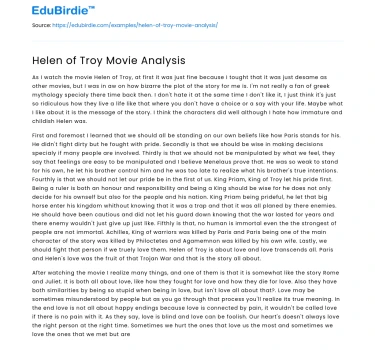Introduction
The tale of Helen of Troy, often dubbed the face that launched a thousand ships, has captivated storytellers for centuries. Rooted in ancient Greek mythology, her story has been adapted into various art forms, including the realm of cinema. The film "Helen of Troy," directed by Robert Wise in 1956, offers a cinematic retelling of this legendary narrative. Through a meticulous examination of character portrayals, thematic elements, and historical accuracy, the film provides a window into mid-20th-century perspectives on mythological storytelling. This essay aims to critically analyze "Helen of Troy," focusing on its narrative structure, its portrayal of Helen as a central figure, and its historical context. By engaging with the film's artistic decisions, we seek to understand how it shapes and reflects cultural attitudes towards myth and history. Moreover, this analysis will acknowledge differing interpretations, thereby presenting a balanced view of this cinematic endeavor.
Narrative Structure and Cinematic Techniques
The narrative structure of "Helen of Troy" is pivotal in understanding its impact as a film. By employing a linear storytelling approach, the film adheres closely to the traditional epic framework of the Trojan War saga. This method allows audiences unfamiliar with the myth to easily follow the complex web of events leading to the war. Cinematic techniques such as wide-angle shots and dramatic score compositions are employed to emphasize the grandeur and scale of the unfolding drama. The utilization of these techniques mirrors the epic nature of the original Homeric sources. For instance, the film's depiction of the launching of a thousand ships is captured through expansive, visually arresting sequences that reinforce the sheer magnitude of the myth.
Save your time!
We can take care of your essay
- Proper editing and formatting
- Free revision, title page, and bibliography
- Flexible prices and money-back guarantee
However, critics argue that this adherence to a linear narrative may oversimplify the intricate character motivations and political intricacies present in the original myth. According to film scholar Mary Louise Pratt, "the film's straightforward storytelling might dilute the complexities of human emotions and divine interventions that characterize the ancient epic" (Pratt, 1957). Despite this criticism, the film successfully captures the essence of the story's epic scale, making it accessible to a broader audience, which is a significant achievement in cinematic adaptation.
Characterization of Helen and Thematic Exploration
The portrayal of Helen is central to the film's narrative and thematic exploration. Helen, played by Rossana Podestà, is depicted as a figure of both beauty and agency, highlighting her role as more than a passive object of desire. This interpretation aligns with mid-20th-century feminist perspectives, which began to challenge traditional depictions of women in classical mythology. The film presents Helen as a complex character, caught between her desires and the societal expectations imposed upon her. Through this lens, the film examines themes of power, autonomy, and the consequences of beauty.
Yet, some scholars argue that the film's portrayal of Helen still falls short of fully realizing her as a multifaceted character. Historian Edith Hamilton notes that "while the film attempts to give Helen agency, it ultimately reverts to portraying her as a pawn in the larger game of gods and men" (Hamilton, 1956). This critique points to the tension within the film's narrative between maintaining fidelity to the myth and offering a modernized interpretation of Helen's character. Nonetheless, the film's engagement with these themes reflects a conscious effort to address contemporary gender dynamics, making it a valuable artifact for studying cultural shifts in the portrayal of mythological figures.
Historical Context and Cultural Reflection
The film "Helen of Troy" emerges from a specific historical and cultural context that influences its interpretation of the myth. Produced during the 1950s, a period marked by post-war reconstruction and a fascination with grand historical narratives, the film reflects contemporary societal values and concerns. The emphasis on themes of heroism, sacrifice, and destiny can be seen as a reflection of post-war optimism and the desire for stability and order. In this context, the myth of Helen and the Trojan War serves as both an escapist fantasy and a moral allegory for audiences grappling with the aftermath of global conflict.
However, this cultural lens also introduces anachronisms and biases into the film's portrayal of ancient Greece. As noted by classicist Bernard Knox, "the film's presentation of Greek society is filtered through a mid-20th-century lens, leading to a romanticized and sometimes inaccurate depiction of ancient customs and practices" (Knox, 1957). Despite these historical inaccuracies, the film serves as a compelling example of how popular media can shape and reflect cultural attitudes towards history and mythology. By understanding these influences, viewers can gain insight into the ways in which cinematic adaptations serve as mirrors to the society from which they originate.
Conclusion
In conclusion, "Helen of Troy" stands as a significant cultural artifact, offering insights into mid-20th-century interpretations of classical mythology. Through its narrative structure, characterization, and thematic exploration, the film engages with enduring questions about beauty, power, and the human condition. While it faces criticism for certain narrative simplifications and historical inaccuracies, the film's ability to capture the epic scale of the Trojan War narrative has cemented its place in the canon of mythological cinema.
The film's portrayal of Helen as a complex figure reflects evolving cultural attitudes towards gender and power, making it a valuable subject for continued scholarly analysis. As we consider counter-arguments and differing interpretations, it is crucial to recognize the film's role in shaping popular perceptions of myth and history. Ultimately, "Helen of Troy" invites audiences to reflect on the timeless nature of myth and its capacity to adapt and resonate across different cultural contexts.






 Stuck on your essay?
Stuck on your essay?

